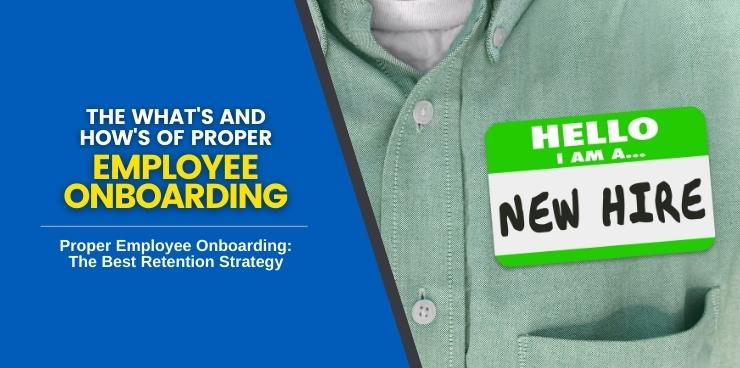No company desires employee attrition, especially in a niche with a tight labor market. This is particularly true for skilled workers, like in the residential home services industry. Ideally, you want to keep your employee retention rate high and turnover rate low, but how do we do that?
One essential piece is effective employee onboarding.
You know all the obvious solutions like increasing pay, better benefits, a fancy title, or employee recognition programs. They’re helpful but they are only satisfying their external motivators — pay, praise, and power. They don’t connect with the far more powerful internal motivators — identity, purpose, and adventure.
Done right, new hires will feel like they’re part of the company, serving a higher purpose, and being challenged to progress through your rank and file. It begins when a new employee walks in and feels welcome and part of the team. It continues by how passionate you are about what you are here to do. You communicate how much they matter to you by teaching them what they need to know and challenging them to follow a proven process that provides them with the best results.
All these things add up and make the employee feel like a team member instead of an outsider looking in. This is why it is so essential to have effective and thorough employee onboarding strategies.
In this article, we’ll tackle the essentials of employee onboarding. This includes the turnover problem in North America and its effect on a company’s integrity. Finally, how refining your onboarding process can improve your employee retention rates.
The Problem of High Turnover is Getting Bigger
Retaining top talent is essential in any business, including home services. However, the statistics on employee turnover rates in 2021 say the overall turnover rate is 57.3%. Considering only the voluntary separations, the number dips to 25%. It spikes to 29% for involuntary turnover, and only 3% if we account for high-performing employees.
It’s more painful for businesses employing skilled labor like HVAC and plumbing. You have more to lose when Skilled Techs are the ones that drive your business results. Because of the unprecedented demand for skilled labor, competitors are aggressively pursuing your team. Without a strong retention strategy, you are certain to lose one of your most precious assets.
According to ACHR News, employee turnover in the HVAC industry is primarily driven by those who are retiring. However, unhappy employees also add to the turnover rate. This has led business owners to conceptualize new approaches for employee retention. One of the issues is the high workload. Many people leave the trade because of burnout, especially during peak season.
While strenuous for Technicians and their bodies, it isn’t without benefits because HVAC Techs should be compensated accordingly. When new Techs understand this beforehand, things can be different. Disclosing vital information like this during the onboarding process will yield more positive results.
There are preemptive measures companies can employ to minimize employee turnover, and it isn’t complex. The employee onboarding process can help immerse new hires into the system and prevent cognitive dissonance.
Improving your employee onboarding approach is one big leap to protecting and defending a happy, healthy, and wealthy culture. If you need any help with this, book a call with Wizard of Sales®.
True Cost of Employee Turnover
The biggest concern of companies during employee turnover is normally the financial losses that come along with it. The numbers don’t lie, and it’s costing employers a huge chunk. Data from the Work Institute indicates that employee turnover costs as much as 33% of an employee’s annual salary. When we try to use that formula for the median annual salary of a plumber. The cost of turnover per worker results in roughly $18,000.
Although the problem here is that costs are not limited to monetary factors. There are other hidden costs that residential home service companies suffer from during employee turnover.
Revolving Door of Employees Disrupts Your Entire Business
When there is low employee retention, you don’t only account for the cost of the lost Technician. The true cost of employee turnover is far more extensive, and it can threaten the integrity of your entire business.
Primarily, your buying experience, culture, and productivity suffer along with employee turnover.
Customer Experience
As a business, we always vow to give our customers the optimal experience at every touchpoint. However, during high turnover rates, it’s far more difficult to keep this promise.
The domino effect of employee turnover creates a cascade of consequences for your business, and it begins with your customers. When there are high employee turnover rates, it often means:
- Inexperienced Technicians are servicing customers
- There is inconsistency in the quality of work
- Customers have to re-explain their situation to each new employee
All of this hurts your business reputation leading to lower customer loyalty. In order to give your clients the best experience possible, you need a team of knowledgeable and experienced Technicians. With high employee turnover rates, this becomes increasingly difficult to maintain. Consequently, your customers suffer.
In-business Culture
Whenever someone leaves the company, you’ll never stop the office gossip and employees taking time to wonder why. This negative environment is one of the first changes you’ll notice after losing an employee. More often than not it strains your team’s morale.
Losing a beloved employee can also hinder your company’s culture. The employee leaving may have been the life of the office or someone everyone looked up to. This situation creates a void that is difficult to fill and impairs the existing culture.
What’s more, when an employee quits it adds to the workload of those who are left behind. The remaining employees often have to pick up the slack which can lead to frustration and resentment.
 Workplace Productivity
Workplace Productivity
Lower morale often leads to equally sluggish turnaround time within a business. Anxiety among employees can take a heavy toll on their work quality and efficiency. Moreover, fewer members are left to cover the additional workload left by the employee. This can lead to overwhelmed workers, burnout, and even poorer performance.
It can be difficult to find the right candidate to fill an employee’s shoes. Even if you manage to replace them, transitioning into full productivity can take months. Not to mention the hiring process is time-consuming and costly.
The solution to these employee retention problems is proper employee onboarding. By taking the time to properly onboard new employees, you can mitigate the risk of them leaving. Thereby decreasing the likelihood of losing key members of your team.
There’s a Better Way To Onboard Employees
The onboarding process helps new hires adapt and get their bearings with the new position. More importantly, employee onboarding immerses the new worker in the company’s philosophies, rules, guiding principles, and roles. The goal of onboarding is to prepare new hires for you way of doing things and to make them feel as a valued and integrated part of your tribe. This builds their commitment to the business’s success and supports new workers in embodying the position.
However, having an onboarding process isn’t enough to elinimate your employee turnover rate. Even companies that deploy employee onboarding still suffer from attrition. You want to implement the BEST onboarding tactics if you want a high employee retention rate.
In the biz, there’s the conventional way of onboarding employees, and then there’s the new and improved method. I’ll share the secret sauce with you below.
But first…
One of the biggest errors that companies make when onboarding is merging the onboarding process with orientation. This is a critical mistake because they’re two different things.
Employee orientation is focused on the company. It’s where you tell new hires everything they need to know about your business: its mission, vision, external roles, etc. Moreover, orienting the new employee will also tackle necessary information like their beginning date, required paperwork, and other routine tasks.
Employee onboarding should begin AFTER the orientation is been dealt with.
The Usual Way
The usual employee onboarding process entails filling out mountains of paperwork on the employee’s first day. The employee is toured around the office, introduced to their co-workers, and sat down at their desk with a computer. They’re given a quick run-through of the company’s workflows and policies, and they’re left to their own devices.
Some companies choose to squeeze in hyper-focused training sessions within the first few weeks. The problem with this is that it is a firehose of information firing at a teacup of a new hire. This myriad of details leads to information overload. New employees will then have to juggle learning everything about the company while figuring out how they fit in.
After employees receive the “deemed” necessary training, it then stops. Abruptly. Like a partner, whom you’ve genuinely invested in, that ghosted you without closure. This causes new hires to quickly forget what they’ve learned, especially if there weren’t workplace opportunities to implement the training.
You know how the rest goes. Being lost in their position (and in translation), their morale drops. Productivity suffers. They reboot and then start learning how things work on their own, or worse, they quit. This is the reason why employee onboarding costs more money than it should.
 The New Way
The New Way
Employee onboarding doesn’t have to be a one-size-fits-all kind of program. It should be flexible enough to accommodate the employee’s role, their level of experience, and even their learning style. Most importantly, it shouldn’t stop after the first few weeks or months on the job. The new way of employee onboarding is a never ending process. Yet, it’s proven to help new hires acclimate to the position and reduce their time to productivity.
The key here is to avoid bombarding new hires with overwhelming information from the get-go. Instead, provide them ONLY with the most relevant information to get started on the job. As long as they have enough headroom to fulfill their role, they’ll manage it from there provided readily available support.
Unlike the usual way where training abruptly stops. The new way calls for continuous provision of personalized bite-sized learning and reinforcement to help them embody the position better. Doing this will prevent gaps in their learning process which props them up for success long-term. Give them relevant information when needed, in a format that works for them. This will help them stick around and become valuable team members.
Do You Have Proper Employee Onboarding?
We can never understate the importance of an effective employee onboarding program. Even if your company doesn’t suffer from a notoriously high employee turnover rate, you will always benefit from proper onboarding.
- You cut down the time to productivity of new hires
- You help mold and fit them perfectly into your tribe
- You improve employee satisfaction and commitment
If you’re in the residential home services industry, employee onboarding is especially important. Turnover rates in this industry are high, and the cost of employee onboarding is even higher. It’s crucial to help new talents feel comfortable and confident in their roles if you want to prevent attrition. If not, you lose talents, and worse, relinquish valuable employees to your competition.
The goal is to protect and defend a happy, healthy, and wealthy culture. Wizard of Sales® can help you make that a reality. Book a call.



 Workplace Productivity
Workplace Productivity The New Way
The New Way